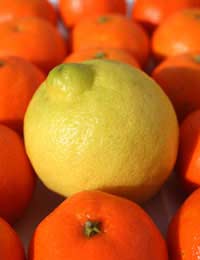
It’s hard to imagine life without an orange to juice into a delicious drink, or a lemon to squirt over our pancakes. These fruits aren’t native to the UK but are as much a part of our food culture as an apple or pear.
All citrus fruits are acidic. This means they are excellent detoxifiers, which means they help remove harmful toxins from the body. They are bursting with vitamin C and calcium and can help prevent colds and flu, if eaten regularly.
The citrus fruit family includes clementines, grapefruit, kumquats, lemons, limes, mandarins, tangerines, tangelos, oranges and satsumas.
Clementine: the clementine is a seedless mandarin. It can be juiced or eaten raw as a snack.
Grapefruit: the grapefruit has a pale yellow skin and is slightly larger than an orange. Its flesh can be either pink or white with a slightly bitter flavour. They can be juiced, eaten raw or made into a marmalade.
Kumquat: the kumquat is not technically a citrus fruit. It comes from a similar fruit family, called fortunella. It looks like small orange and has an edible skin and a tart, citrus flavour. It can be made into a relish or used as a garnish.
Lemon: the lemon is a bright yellow oblong fruit roughly the same size of an orange. It has a tangy, sour flavour and is used in cooking to add a kick to many dishes. It can also be used as an ingredient in lemon curd.
Lime: the lime is a small, lemon-shaped green fruit with a tangy, sweet flavour. It is used in a lot of Indian and Thai cooking, and can be sliced and added to drinks.
Mandarin: the mandarin is a type of small orange. It has loose skin and seeds inside. A seedless version of the mandarin is the clementine. It can be juiced or eaten raw as a snack.
Oranges: there are several different types of oranges. These include: navel, Valencia and blood oranges. They can be eaten raw as a snack, juiced, made into marmalade, or used as an ingredient in cakes.
Navel orange: the navel orange is often considered to be the tastiest eating orange in the world. It has a meaty flesh with easy-to-peel thick rinds and no seeds.
Valencia orange: the Valencia or Murcia orange is a very sweet orange that’s normally used for juicing.
Blood orange: the blood orange is darker and more bitter than regular oranges, and has streaks of red in the fruit. Its juice is a dark burgundy colour.
Tangelo: the tangelo is a cross between a tangerine, a grapefruit and an orange. It can be caramelised and added to salads, made into a marmalade or served with fish.
Satsumas: the satsuma is similar to a clementine but is has tighter skin. It is normally eaten on its own as a snack, but can also be juiced.
Tangerines: the tangerine is an orange-red mandarin with a very citrus taste. It is great for juicing and is also eaten raw as a snack.


Hi, I have lots of beautiful organic kumquats to preserve. I plan to use them in 6 months with Christmas dishes–half mustard fruits and half candied. I have a few particularly pretty sprigs that I would like to keep whole for topping cakes. Is it possible to preserve them with the leaves attached? I’d be very grateful for some expert advice! ??